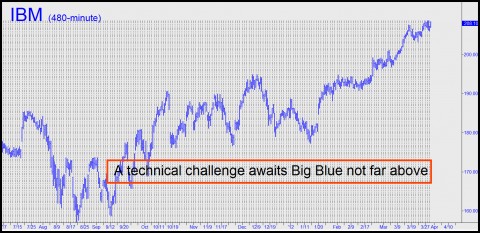You gotta give DaBoyz credit for turning stocks around yesterday, since buyers appeared to have taken the day off. Nor was there much bullish energy as the day wore on – only the nervous drum beat of short-covering ahead of the final trading day of Q1. It was all window dressing, to be sure, and although the Dow Industrials ended the day 20 points higher, the modest gain belied the dark magic that eventually spirited the blue chip average into positive territory. After being down as much as 93 points early in the session, the Indoos began to inch their way higher around noon. Of course, most of the gains came during the final hour, as is so often the case. Bears apparently had second thoughts about trusting Friday to be mellow, especially a Friday coinciding with the end of a fiscal quarter.
With earnings growth apparently slowing down, will the broad averages continue to waft higher in the weeks ahead? Perhaps. Whatever your view on the economy, keep in mind that there is no story, even weakening earnings, that cannot be spun bullishly. The optimists would interpret this as meaning companies have hit a wall on profit margins and will soon start hiring to keep up with sales. A darker view would hold that stagnant household incomes and still-falling home prices are about to smother the consumption side of growth. Yes, we too have noticed that credit card teaser rates are back down to 0.0%, sometimes with no origination fee. But the asset growth on which this seductive scam has always thrived is simply not there.
‘Time for Defense’
Meanwhile, not everyone thinks that higher stock prices are baked in the cake for Q2. “Traders and investors should use Friday, March 30, to get defensive,” read an e-mail we received from Phil C., a market timer and friend who has had some hits and misses in the last year (as who has not?). “Sell big winners like AAPL and IBM, or at least use defensive option strategies to take profits and establish trades to profit from corrections,” noted Phil. “The March correction in gold and silver should also end on Friday. Go long gold and silver and CEF.” Nothing like a clear call. Our own technical work suggests that he may be onto something. Although we have no great urge to get in the way of Apple’s rampage, bellwether IBM is nearing a potentially important rally target that we’d warned subscribers about a while back. We also think a strong upturn is imminent in bullion shares. Accordingly, we have told subscribers precisely where they should “back up the truck” to aggressively buy Newmont Mining stock, for one, as well as shares in the Junior Gold Miner ETF (GDXJ). [ Click here for a free week’s access to our detailed forecasts, trading recommendations and 24/7 chat room.] As always, interesting times are apt to provide challenges as well as opportunities. Will you be ready for them as a new month, and a new quarter, begin?
***
(If you’d like to have these commentaries delivered free each day to your e-mail box, click here.)


Sure fiat has intrinsic value. It is backed by public initiative – which certainly has value. Ask any country we’ve ever been at war with.
The following still holds:
…“Why is state money better than gold?”
Because the highest return is always the return-on-coordination.
Scaling up ability to explore large-group options requires 1) scalable large-group agility,
2) and scalable large-group intelligence,
3) and coherent alignment to emerging options.
Same reasons no species or armies are resource constrained. The bigger constraint is always organizational ability.
That means that only state-money denominations are agile enough to keep up with the kinetic demands of uncontrollable public initiative.
Commodity-money was thoroughly tested, and was found inadequate. It’s valuation has to be constantly re-scaled, simply because populations & their options scale faster than the magnitude of any commodity store.
If that’s the case, just simplify and cut the commodity out of the re-scaling loop that links organizational ability to group outcomes.
Ask yourself if the USMC, or the USA, will ever be constrained by a given commodity store, be it whale-oil, gold, or anything else. There’s always a way to scale up further, and it always involves another layer of indirection.